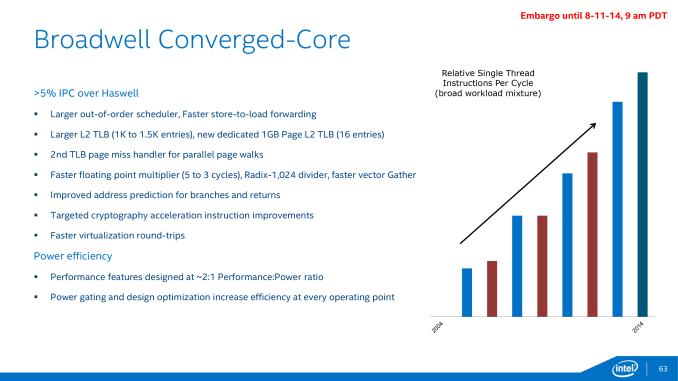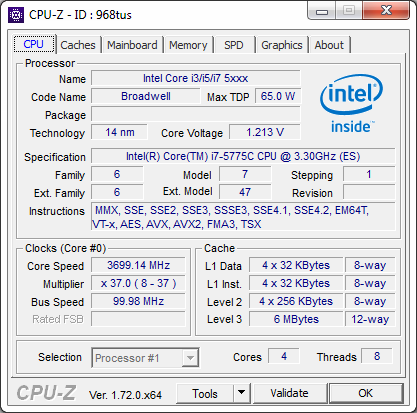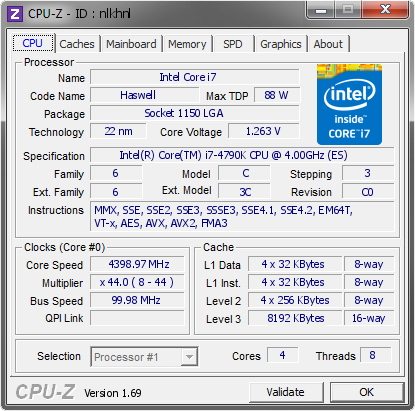Intel Haswell Vs Broadwell Vs Skylake
In our first function of our Broadwell coverage, we rushed to examination both the i7-5775C and the i5-5765C in our new benchmarking suite against the previous generation of Haswell processors likewise every bit AMDs Kaveri lineup. In Part 2, nosotros take spent more than time with the architecture to see how it stacks upward against the final 4 years of Intel, as well equally probing the loftier finish overclocking capabilities.
Since our Part 1, the news mill from Intel has been an interesting mix of reduced revenue from the PC segments but a rise in expectation as we move from a dull Q2 into an exciting Q3 with back-to-school sales on the horizon and the release of Windows x. Throw into the mix details well-nigh Intel's delayed 10nm procedure node, the injection of Kaby Lake processors after Skylake to break the tick tock model and information technology becomes an interesting adjacent few years for the industry.
No affair the state of the tick-tock model (or what seems to be a tick-tock-tock with Kaby Lake), Intel'south goals are still the same - better efficiency of the main processor design and boost summit performance though instruction per clock (IPC) gains with each new processor design release. Simply stating you lot desire an comeback in IPC and actually designing the semiconductor to get a heave in performance are 2 contrary ends of the difficulty spectrum.
Broadwell vs. Haswell
Intel'southward line of Haswell (fourth generation) processors were released in June 2013, with a small updated pattern called Haswell Refresh in mid-2014 with improved frequencies and a minor a packet upgrade to benefit temperatures. Haswell is the proper noun of the architecture, updating from the architecture on Ivy Bridge but on the same 22nm process node as Ivy Bridge. An architecture update incorporates a numerical of things - either a paradigm shift in the underlying semiconductor blueprint, or a step up from the previous orientation by aiming for the depression hanging fruit (times which tin be updated for the most gain and the least effort). As a result, architecture jumps unremarkably produce large (v-25%) jumps in performance. This is a tock, to use Intel's nomenclature.
| Intel's Tick-Tock Cadence | |||||
| Microarchitecture | Process Node | Tick or Tock | Release Year | ||
| Conroe/Merom | 65nm | Tock | 2006 | ||
| Penryn | 45nm | Tick | 2007 | ||
| Nehalem | 45nm | Tock | 2008 | ||
| Westmere | 32nm | Tick | 2010 | ||
| Sandy Bridge | 32nm | Tock | 2011 | ||
| Ivy Bridge | 22nm | Tick | 2012 | ||
| Haswell | 22nm | Tock | 2013 | ||
| Broadwell | 14nm | Tick | 2014 | ||
| Skylake | 14nm | Tock | 2015 | ||
| Kaby Lake (link)? | 14nm | Tock | 2016 ? | ||
The other half of the equation is a tick, or the movement from a larger procedure node to a smaller process node. This is generally a scaled reduction in the mask used for the processor, simply there are potential benefits based on the die area of the components of the processor and the connections within. Moving downward to a smaller node typically does non change the base hardware underneath, simply optimizations are made based on that die area reduction. With this in mind, we typically see smaller benefits in performance (5-10%), but better improvements in power consumption due to smaller transistors needing less voltage (although this is a balance between college leakage currents). Overall, the typical goal of a process node change is typically efficiency, making it favored in mobile platforms.
Moving from Haswell to Broadwell on the desktop is a process node change, migrating from 22nm on Haswell to 14nm on Broadwell. As a consequence, the first processors released under the Broadwell nomenclature were mobile focused (Core M), and the desktop end of the stack u.s.a. the last ane to exist updated. Though the desktop side is more subtle than that - Intel has released mid-powered versions of the processor with high end integrated graphics, an approach normally reserved for mobile devices or integrated devices such as all-in-ones. Perhaps it is and then unsurprising that when desktop processors are launched under the -South or -DT naming scheme, Broadwell on the desktop is part of the -H line, normally reserved for mobile processors.
We've commented on Broadwell'southward modest architecture adjustments over Haswell before. They focus on reducing enshroud misses and keeping more predicted operations in flight at any one fourth dimension, reducing the need to move back out of retention and increase throughput. This is generally achieved past exploiting the available surface area when role units are reduced in size from the node change - increasing the out-of-order scheduler size, increasing the L2 TLB to allow for both more local misses/larger memory jump requests, and the page miss handler doubles in size.

This, according to Intel, accounts for a 5% increase in IPC (instructions per clock) past focusing on reducing the look time for data for the traditional CPU part of the Broadwell processor.
In our initial review of the Broadwell processors, we saw that it was not every bit straightforward as this. The ii CPUs we tested, the i7-5775C and the i5-5675C, are built to a 65W thermal blueprint ability, compared to the high end models from Haswell which are at the 84/88W level. This means that for users looking for the next well-nigh powerful processor, the base of operations processor frequencies of the Broadwell samples nosotros had are lower and less performant due to frequency, more than whatsoever IPC increase could overcome.


Core i7-5775C lining up with the Core i7-4790K
Information technology was hard for Broadwell to win whatever CPU focused benchmark from a pure frequency (and TDP) handicap. To add an additional chemical element into the mix, almost every Broadwell'southward memory cache system is also unlike:
| Intel Desktop Processor Cache Comparison | |||||
| L1-D | L1-I | L2 | L3 | L4 | |
| Sandy Span i7 | 4 ten 32 KB | 4 x 32 KB | iv x 256 KB | viii MB | |
| Ivy Bridge i7 | 4 10 32 KB | 4 x 32 KB | 4 10 256 KB | 8 MB | |
| Haswell i7 | 4 x 32 KB | 4 x 32 KB | 4 x 256 KB | 8 MB | |
| Broadwell i7 (Desktop / Iris Pro 6200) | 4 10 32 KB | 4 x 32 KB | 4 x 256 KB | 6 MB | 128 MB eDRAM |
| | |||||
| Haswell i5 | four ten 32 KB | 4 10 32 KB | 4 ten 256 KB | vi MB | |
| Broadwell i7 (i7-5700HQ / Hd 5600) | iv x 32 KB | four 10 32 KB | 4 x 256 KB | half-dozen MB | |
Both the Level i and Level two caches of each processor are the same, simply at Level 3 where Haswell i7 has 8MB, the Broadwell i7 only has 6MB. Aside from the improved branch predictor mentioned higher up to reduce cache misses, Broadwell also has a separate eDRAM in the CPU parcel, weighing in at 128MB. This acts as a level 4 cache, having a latency between the L3 and moving out to retention, resulting in less trips out to main retention. This combination of architecture improvements and eDRAM on Broadwell combined with the lower L3 cache size makes it an unknown in memory performance.
I have also included the Haswell i5 and the Broadwell-based i7-5700HQ in this table, showing that the Broadwell i7 L1/L2/L3 cache bureaucracy is more akin to a desktop i5 processor and that Broadwell is available without the eDRAM. That being said, the i7-5700HQ is a single processor destined for laptops, making any discrete testing nominally incommunicable, and taken out of the existent-world context for the majority of Broadwell desktop owners.
The reason for Broadwell'due south eDRAM comes from Intel's 'Crystal Well' strategy. Crystal Well is a designation given to a processor which has this eDRAM (and typically a larger integrated graphics package also). Integrated graphics are historically inhibited by retention bandwidth, having to nearly e'er achieve out to chief memory to process textures in graphic workloads. The eDRAM allows more data to be stored between the graphics core and the memory, and at a college memory bandwidth, potentially improving output. By combining the high end integrated graphics with the eDRAM, Intel created these Broadwell processors every bit the fastest integrated graphics solution available on a socketable (replaceable processor) platform.
That being said, due to Broadwell being the latest production from Intel, and it having the most recent (and expensive) process node, equipped with eDRAM which is a separate die on the package, the Broadwell solutions practise not come cheap. The pricing is nearly in line with previous Haswell mainstream i7 processors, albeit at the lower thermal design and the beefier integrated graphics. Every bit we determined in the Broadwell Role 1 review, the desktop Broadwell has the absolute integrated performance crown, although an AMD APU system will be significantly more cost effective. Both platforms are hoping that multi-GPU possibilities in DirectX12 have a positive upshot to their solutions.
This Review
Nosotros said we'd be dorsum for part 2, and this is it. Here I wanted to cover what we couldn't previously due to early BIOS revisions and express fourth dimension testing - specifically looking at how Broadwell performs when overclocking, and whether the Broadwell architecture is truly a stride upwardly over previous generations of Intel processors. In the last review our comparison point was the i7-4770K from Intel'south Haswell line; for part two we also back tested the i7-3770K from the Ivy Bridge platform and the i7-2600K from Sandy Bridge, covering the 4 most recent Intel processor architectures dating back to Jan 2011. Nosotros likewise have data on older benchmarks going back further. All four of the virtually recent architectures are tested at their stock speeds and at a constant 3 GHz (at 1866 C9) to discover how IPC improves. (Incidentally I did find an i7-750 and a Q9550 in my CPU bin for the side by side two generations back, but have no motherboards for testing our more than recent benchmarks. I'll see what I tin put together for a mini-piece afterwards in the year.)
Exam setup
Many thanks to
Thank you to AMD for providing us with the R9 290X 4GB GPUs.
Thank you to ASUS for providing us with GTX 980 Strix GPUs and the R7 240 DDR3 GPU.
Thank you to ASRock and ASUS for providing the states with some IO testing kit.
Cheers to Libation Master for providing united states with Nepton 140XL CLCs.
Thanks to Corsair for providing us with an AX1200i PSU.
Thanks to Crucial for providing united states with MX200 SSDs.
Thank yous to Thousand.Skill and Corsair for providing us with retentivity.
Thank you to MSI for providing us with the GTX 770 Lightning GPUs.
Thank you to OCZ for providing us with PSUs.
Thank you to Rosewill for providing the states with PSUs and RK-9100 keyboards.
Overclocking Broadwell
Source: https://www.anandtech.com/show/9482/intel-broadwell-pt2-overclocking-ipc
Posted by: crowderdinduch.blogspot.com

0 Response to "Intel Haswell Vs Broadwell Vs Skylake"
Post a Comment